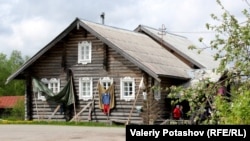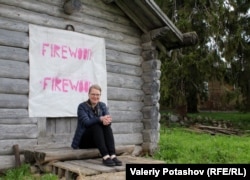KINERMA, Russia -- "I took my goats out to graze this morning," 86-year-old Ivan Yershov tells RFE/RL one recent sunny afternoon. "But out there in the field, they are hammering and sawing. The goats were frightened, so I had to drive them home."
Skittish goats are not the only indication of something unusual going on in the tiny village of Kinerma, some 100 kilometers west of Petrozavodsk in the heart of Russia's Republic of Karelia. The quaint wooden houses -- many of them protected landmarks dating as far back as the 16th century -- lining the village's unpaved streets are festooned with ragged laundry, tarps, and handwritten banners with the strange English slogan "Firewood."
The makeshift decorations are a protest against a Moscow-based film crew that has swept into town to make a feature film using the picturesque hamlet as a backdrop.
"We tried to play on the word 'Hollywood' in naming our protest 'Firewood,'" protest organizer and Kinerma local Olga Gokkoyeva says. "But essentially we are nothing but firewood for these filmmakers, which begs two questions: Do we have a feeling of self-respect, and do we think Kinerma is a real part of our cultural heritage that is worthy of preservation and respectful treatment?"
The very name of the film, which is being made by the production company of Oscar-winning filmmaker and head of the Russian Cinematographers Union Nikita Mikhalkov, is enough to strike terror into the hearts of the seven people living year-round in the ancient wooden architecture of Kinerma -- Fire!
"On May 9, they brought in logs to our field and started working," says local Anna Kuznetsova, who is Gokkoyeva's mother. "I asked them what was going on and they told me they were making a film about firefighters. 'We aren't going to burn anything,' they said. 'We'll just have some smoke.'"
"But where there is smoke, there is fire," Kuznetsova says dubiously.
"Our village miraculously survived the war," she adds, referring to the 1939-40 Winter War between Finland and the Soviet Union and World War II, which came to the region beginning in 1941. "The fighting passed us by. But now we don't know if we'll be burned out or not. They are working just 200 meters from the village. Can you imagine if some sparks get loose?"
The Trite production company declined to comment for this article.
Russia's Most Beautiful Village
To some extent, Kinerma's problems are the result of its own success. In 2016, it was named the most beautiful village in Russia, prompting a significant influx of tourists. During the warm months, at least one bus pulls into town every day to soak in the atmosphere of timeless Russia.
This year, visitors are greeted by signs in Russian, English, and Finnish that explain the strange decorations on the buildings and the essence of the protest -- "our negative attitude toward the production of a film about firefighters that is not only disrupting life in our village, but also posing a threat to it."
Yegor Kalmykov, who works as a guide taking tourists to the historical villages of the region, says tourists are sympathetic to the Kinerma protest.
The villagers' hostility to the Fire project also stems in part from their previous experience with outside film-production companies. In 2014, the village served as the backdrop for a TV serial about serfdom, while in 2018 scenes from a film about a Finnish prisoner-of-war camp were filmed there. Locals tell RFE/RL that in both cases the filmmakers treated the locals arrogantly. Farmer Yershov says one company put tiles on the roof of his banya and left them there, forcing him to pull them off and repair the damage himself.
"They were very difficult people, sticking their noses everywhere and not asking permission for anything," Kuznetsova says. "They damaged six or seven roofs -- and the roof is the main thing for a house! They poured sand all over our streets and didn't clean up anything after themselves. We had to restore everything back to order ourselves."
Protest organizer Gokkoyeva says that the earlier experiences were a driving force compelling her to act this time around. She says she still can't forgive herself for remaining idle while filmmakers hung first a portrait of Soviet dictator Josef Stalin and then a swastika from the bell tower of the ancient village chapel.
"Russia is full of abandoned villages, but for some reason no one goes there to make movies," she says. "Kinerma is our national heritage, but for filmmakers it is just a readymade set that gives them a chance to save money.... But we are not a decoration!"
'We're Not Here To Burn Anything Down'
Although a schedule for filming Fire has not been announced, intense preparations are under way. An excavator has been hard at work digging into the field, while several large truckloads of hay have been brought in. Danil Novozhilov, the assistant production supervisor on site, tells RFE/RL that he doesn't understand why the locals are upset.
"We are digging a water reservoir, which for some reason they don't have here," he says. "And no one worried that the village would burn down. No one here plans to burn down everything and then run away. We want everything to be safe. This is a professional team."
He declined to say directly whether any real fires would be set during the filming and urged journalists to contact Trite's Moscow office.
Landmarks of Russia's ancient wooden architecture have long been under threat, often falling victim to lightning, neglect, or arson. In August 2018, the 18th-century Uspensky Church near the Karelian city of Kondopoga was destroyed by fire.
Of the 72 wooden churches described in the authoritative 1942 catalogue Russian Wooden Architecture, only 27 still survive, according to architecture specialist Aleksandr Mozhayev.













